Characteristics of Tree Growth at the Early Stage of Natural Succession on Abandoned Farmland in Southwest China’s Karst Region
Abstract
1. Introduction
2. Materials and Methods
2.1. Study Area
2.2. Methods
2.2.1. Tree Selection and Dendrometer Installation
2.2.2. Microhabitat Survey
2.3. Data Analysis
3. Results
3.1. Characteristics of Tree Growth Among Dominant Species
3.2. Temporal Characteristics of Tree Growth
3.3. Distribution of Microhabitats in the Study Area
4. Discussion
4.1. Comparison with Other Research in Similar Climatic Zones
4.2. Main Factors Affecting Tree Growth
4.2.1. Microhabitat Factors
4.2.2. Biological Elements
4.3. Several Suggestions on Vegetation Restoration in the Karst Region of Southwest China
5. Conclusions
Author Contributions
Funding
Data Availability Statement
Acknowledgments
Conflicts of Interest
Abbreviations
| GSNDVI | Growing-season normalized difference vegetation index |
| DBH | Diameter at breast height |
| MA | Melia azedarach |
| PP | Platyosprion platycarpum |
| CF | Catalpa fargesii |
| PA | Populus adenopoda |
| TS | Toona sinensis |
| CO | Catalpa ovata |
| BP | Broussonetia papyrifera |
| PC | Populus canadensis Moench |
| CS | Celtis sinensis |
| TSe | Triadica sebifera |
| RC | Rhus chinensis |
| CM | Castanea mollissima |
| IM | Ilex macrocarpa |
| PPy | Pyrus pyrifolia |
| CA | Choerospondias axillaris |
| LL | Ligustrum lucidum |
| AK | Albizia kalkora |
| CL | Cunninghamia lanceolata |
| LC | Lindera communis |
References
- Wang, Y.; Li, Y. Occurrence Law of Karst Water in Down-Faulted Basins; Yunnan Science & Technology Press: Kunming, China, 2003; p. 140. [Google Scholar]
- Wang, S. The most serious eco-geologically environmental problem in Southwestern China—Karst rocky desertification. Bull. Mineral. Petrol. Geochem. 2003, 22, 120–126. [Google Scholar]
- Shi, Y.; Wang, L.; Zhu, W.; Su, W.; Li, P. The model of water resource utilization in karst area in Southwest China. Sci. Technol. Rev. 2005, 23, 52–55. [Google Scholar]
- Zhang, X.; Wang, K. Ponderation on the shortage of mineral nutrients in the soil-vegetation ecosystem in carbonate rock distributed mountain regions in Southwest China. Earth Environ. 2009, 37, 337–341. [Google Scholar]
- Zhou, Y.; Pan, G. Adaptation and adjustment of Maolan forest ecosystem to karst environment. Carsologica Sin. 2001, 20, 47–52. [Google Scholar]
- Jiang, Z.; Liu, H.; Wang, H.; Peng, J.; Meersmans, J.; Green, S.; Quine, T.; Wu, X.; Song, Z. Bedrock geochemistry influences vegetation growth by regulating the regolith water holding capacity. Nat. Commun. 2020, 11, 2392. [Google Scholar] [CrossRef] [PubMed]
- Chen, W.; Ren, M.; Lu, Z.; Wang, N. Research on the property of soil geochemistry in typical karst area in Guizhou Province. Carsologica Sin. 2010, 29, 246–252. [Google Scholar]
- Wang, S.; Ji, H.; Ouyang, Z.; Zhou, D.; Zheng, L.; Li, T. A preliminary study on the weathering of carbonate rocks. Sci. China (Ser. D) 1999, 29, 441–449. [Google Scholar]
- Yuan, D. On the karst ecosystem. Acta Ecol. Sin. 2001, 75, 336–338. [Google Scholar]
- Zhu, S. Ecological Research on Karst Forest (II); Guizhou Science and Technology Press: Guiyang, China, 1997. [Google Scholar]
- Yu, W.; Dong, D.; Ni, J. Comparisons of biomass and net primary productivity of karst and non-karst forest in moutainuous areas, Southwestern China. J. Subtrop. Resour. Environ. 2010, 5, 25–30. [Google Scholar]
- Ni, J.; Xu, H.; Liu, L. Low net primary productivity of dominant tree species in a karst forest, southwestern China: First evidences from tree ring width and girth increment. Acta Geochim. 2017, 36, 482–485. [Google Scholar] [CrossRef]
- Yang, H.; Cheng, S. Study on biomass of the karst forest community in Maolan, Guizhou Province. Acta Ecol. Sin. 1991, 11, 307–313. [Google Scholar]
- Zhu, S.; Wei, L.; Chen, Z.; Zhang, C. A preliminary study on biomass components of karst forest in Maolan of Guizhou Province, China. Acta Phytoecol. Sin. 1995, 19, 358–367. [Google Scholar]
- Chen, C.; Park, T.; Wang, X.; Piao, S.; Xu, B. China and India lead in greening of the world through land-use management. Nat. Sustain. 2019, 2, 122–129. [Google Scholar] [CrossRef] [PubMed]
- Brandt, M.; Yue, Y.; Wigneron, J.; Tong, X.; Tian, F.; Jepsen, M.; Xiao, X.; Verger, A.; Mialon, A.; Al-Yaari, A. Satellite-observed major greening and biomass increase in South China Karst during recent decade. Earth’s Future 2018, 6, 1017–1028. [Google Scholar] [CrossRef]
- Zhang, X. The Vegetation Carbon Sequestration Effect and Its Potential in The Southwestern Karst Region of China in the Past 20 Years. Ph.D. Thesis, University of Chinese Academy of Sciences, Beijing, China, 2022. [Google Scholar]
- Yuan, E.; Zhou, Q.; Luo, Y. Contribution of socioeconomic factors to vegetation restoration in karst areas of southwest China. Acta Ecol. Sin. 2024, 44, 6265–6275. [Google Scholar]
- Han, Z.; Song, W. Spatiotemporal variations in cropland abandonment in the Guizhou–Guangxi karst mountain area, China. J. Clean. Prod. 2019, 238, 117888. [Google Scholar] [CrossRef]
- Dong, D.; Ni, J. Modeling changes of net primary productivity of karst vegetation in Southwestern China using the CASA model. Acta Ecol. Sin. 2011, 31, 1855–1866. [Google Scholar]
- Lv, Y.; Zhang, L.; Yan, H.; Ren, X.; Wang, J.; Niu, Z.; Gu, F.; He, H. Spatial and temporal pattern of changing vegetation and the influence of the environmental factors in the karst region of Southwest China. Acta Ecol. Sin. 2018, 38, 8774–8786. [Google Scholar]
- Cai, H.; Yang, X.; Wang, K.; Xiao, L. Is forest restoration in the Southwest China karst promoted mainly by climate change or human-induced factors? Remote Sens. 2014, 6, 9895–9910. [Google Scholar] [CrossRef]
- Zhang, M.; Wang, K.; Liu, H.; Zhang, C.; Wang, J.; Yue, Y.; Qi, X. How ecological restoration alters ecosystem services: An analysis of vegetation carbon sequestration in the karst area of northwest Guangxi, China. Environ. Earth Sci. 2015, 74, 5307–5317. [Google Scholar] [CrossRef]
- Chang, J.; Yue, Y.; Tong, X.; Brandt, M.; Zhang, C.; Zhang, X. Rural outmigration generates a carbon sink in South China karst. Prog. Phys. Geogr. Earth Environ. 2023, 47, 655–667. [Google Scholar] [CrossRef]
- Li, P.; Zhu, J.; Hu, H.; Guo, Z.; Pan, Y.; Richard, B.; Fang, J. The relative contributions of forest growth and areal expansion to forest biomass carbon sinks in China. Biogeosci. Discuss. 2015, 12, 9587–9612. [Google Scholar]
- Qiao, Y.; Jiang, Y.; Zhang, C. Contribution of karst ecological restoration engineering to vegetation greening in southwest China during recent decade. Ecol. Indic. 2020, 121, 107181. [Google Scholar] [CrossRef]
- Tong, X.; Brandt, M.; Yue, Y.; Horion, S.; Wang, K.; Keersmaecker, W.; Tian, F.; Schurgers, G.; Xiao, X.; Luo, Y.; et al. Increased vegetation growth and carbon stock in China karst via ecological engineering. Nat. Sustain. 2018, 1, 44–50. [Google Scholar] [CrossRef]
- Liu, L.; Zhong, Q.; Zhang, Z. High mortality and low net change in live woody biomass of karst evergreen and deciduous broad-leaved mixed forest in Southwestern China. Forests 2018, 9, 263. [Google Scholar] [CrossRef]
- Wang, Y.; Luo, W.; Zeng, G.; Peng, H.; Cheng, A.; Zhang, L.; Cai, X.; Chen, J.; Lyu, Y.; Yang, H.; et al. Characteristics of carbon, water, and energy fluxes on abandoned farmland revealed by critical zone observation in the karst region of southwest China. Agric. Ecosyst. Environ. 2020, 292, 106821. [Google Scholar] [CrossRef]
- Liu, C.; Wei, Y.; Liu, Y. Biomass of canopy and shrub layers of karst forest in Puding, Guizhou, China. Chin. J. Plant Ecol. 2009, 33, 698–705. [Google Scholar]
- Zhou, Z. Scientific Investigation Report of Maolan Karst Forest; Guizhou Science & Technology Press: Guiyang, China, 1987; pp. 1–23. (In Chinese) [Google Scholar]
- Ni, J.; Luo, D.; Xia, J.; Zhang, Z.; Hu, G. Vegetation in karst terrain of southwestern China allocates more biomass to roots. Solid Earth 2015, 6, 799–810. [Google Scholar] [CrossRef]
- Zhang, X.; Yao, C.; Du, T.; Ma, Z.; Zhu, H.; Wang, Y.; Du, F. Three-dimensional visual simulation and root morphological parameter analysis of three slope protection plants in loess region. Res. Soil Water Conserv. 2025, 32, 218–226. [Google Scholar]
- Wang, S.; Lu, H.; Zhou, Y.; Xie, L.; Xiao, D. Spatial variability of soil organic carbon and representative soil sampling method in Maolan karst virgin forest. Acta Pedol. Sin. 2007, 44, 475–483. [Google Scholar]
- Liu, Y.; Wei, X.; Fan, Z.; Chen, L.; Lin, Y.; Fu, P. Annual growth dynamics of Garuga floribunda var.gamblei in tropical karst forests and their response to environmental factors. Acta Ecol. Sin. 2023, 43, 10171–10181. [Google Scholar]
- Liu, Q.; Chen, D.; Hong, W.; Zhuang, X. Growth analysis of 33 ecological broad-leaved tree species in Huizhou hilly area. Guangdong For. Sci. Technol. 2015, 31, 38–46. [Google Scholar]
- Zhou, B.; Fan, Z.; Qi, J. Intra-annual radial growth of evergreen and deciduous tree species and their response to climatic factors in a montane moist evergreen broad-leaved forest in the Ailao Mountains, Southwest China. Acta Ecol. Sin. 2020, 40, 1699–1708. [Google Scholar]
- Liu, L.; Xu, H.; Guo, Y.; Liang, H.; Lu, X.; Zhang, H.; Liang, E.; Ni, J. reconstruction of above-ground biomass and net primary productivity of dominant tree species in Guizhou forests over past five decades based on tree-ring data. Acta Ecol. Sin. 2022, 40, 3441–3451. [Google Scholar]
- Lee, W.; Gadow, K.; Chung, D.; Lee, J.; Shin, M. DBH growth model for Pinus densiflora and Quercus variabilis mixed forests in central Korea. Ecol. Model. 2004, 176, 187–200. [Google Scholar] [CrossRef]
- Zhang, Y.; Liu, Y.; Liu, S.; Zhang, X. Dynamics of stand biomass and volume of the tree layer in forests with different restoration approaches based on tree-ring analysis. Chin. J. Plant Ecol. 2012, 36, 117–125. [Google Scholar] [CrossRef]
- Michael, K.; Neupane, P.; Lotfiomran, N. The impact of tree age on biomass growth and carbon accumulation capacity: A retrospective analysis using tree ring data of three tropical tree species grown in natural forests of Suriname. PLoS ONE 2017, 12, e0181187. [Google Scholar]
- Liu, F.; Wang, S.; Luo, H.; Liu, Y.; Liu, H. Micro-habitats in karst forest ecosystem and variability of soil. Acta Pedol. Sin. 2008, 45, 1055–1062. [Google Scholar]
- Bréda, N.; Granier, A. Intra- and interannual variations of transpiration, leaf area index and radial growth of a sessile oak stand (Quercus petraea). Ann. Sci. Forest. 1996, 53, 521–536. [Google Scholar] [CrossRef]
- Xu, H.; Liu, L.; Guo, Y.; Liang, H.; Ni, J. Tree-rings of dominant species in karst forests in Southwest China and their responses to climate change. Earth Environ. 2018, 46, 23–31. [Google Scholar]
- Wang, B.; Yang, S.; Wang, Y. Estimation on net primary produtivity of vegetation in karst area of Guizhou province. Carsologica Sin. 2007, 26, 98–104. [Google Scholar]
- Shen, Y.; Chen, F. Large heterogeneity of water and nutrient supply derived from runoff of nearby rock outcrops in karst ecosystems in SW China. Catena 2019, 172, 125–131. [Google Scholar] [CrossRef]
- Zhu, S.; He, J.; Wei, L. Study on Feature of Micro-Habitas in Maolan Karst Forest (III); Guizhou Science and Technology Press: Guiyang, China, 2003; pp. 24–29. [Google Scholar]
- Su, J.; Gou, X.; Deng, Y.; Zhang, R.; Liu, W.; Zhang, F.; Lu, M.; Chen, Y.; Zheng, W. Tree growth response of Fokienia hodginsii to recent climate warming and drought in southwest China. Int. J. Biometeorol. 2017, 61, 2085–2096. [Google Scholar] [CrossRef]
- Xiong, H.; Wang, S.; Rong, L.; Cheng, A.; Li, Y. Effects of extreme drought on plant species in Karst area of Guizhou Province, Southwest China. Chin. J. Appl. Ecol. 2011, 22, 1127–1134. [Google Scholar]
- Orwig, D.; Abrams, M. Variation in radial growth responses to drought among species, site, and canopy strata. Trees 1997, 11, 474–484. [Google Scholar] [CrossRef]
- Romà, O.; Josep, P. Tree growth, mortality, and above-ground biomass accumulation in a holm oak forest under a five-year experimental field drought. Plant Ecol. 2007, 189, 291–299. [Google Scholar]
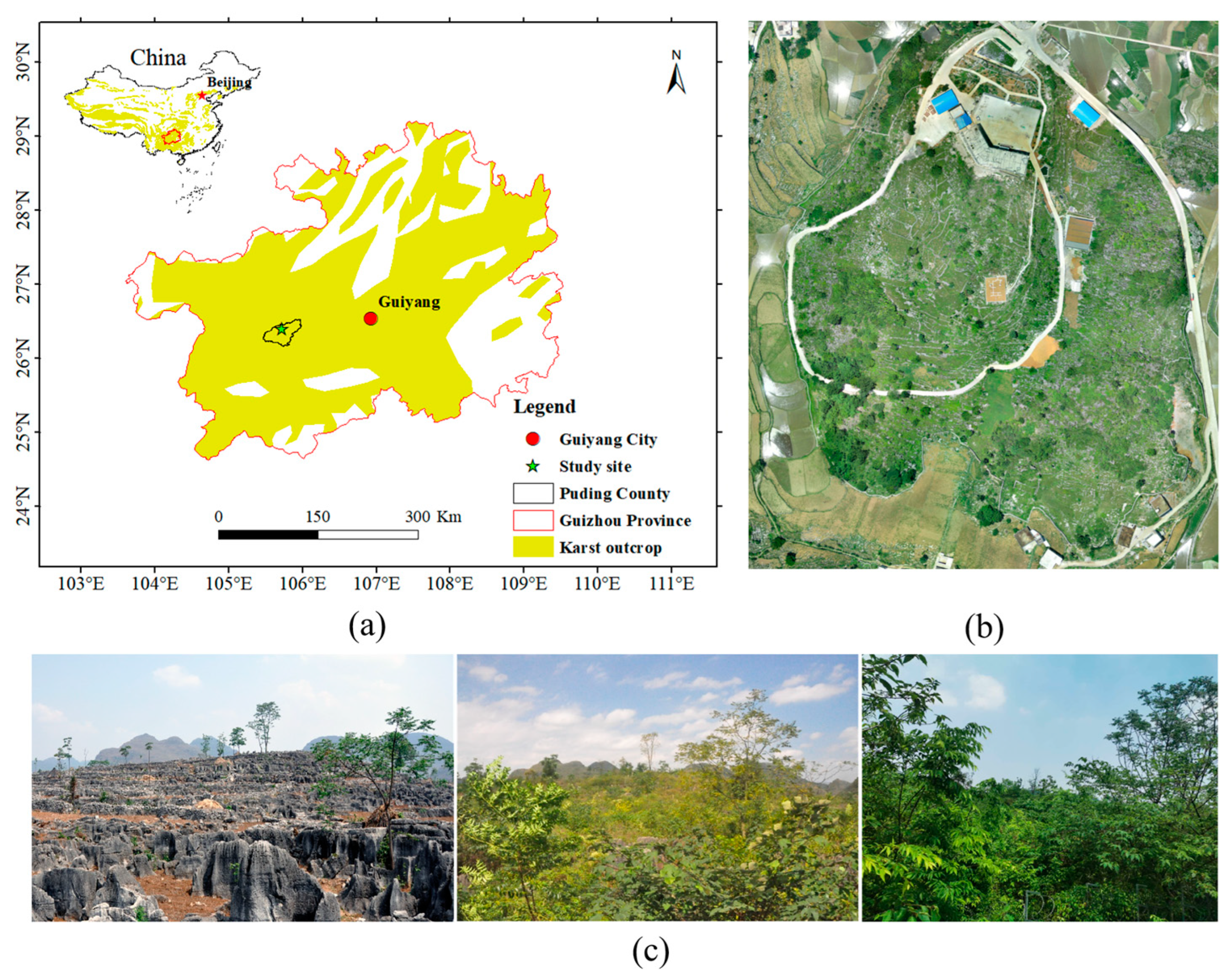
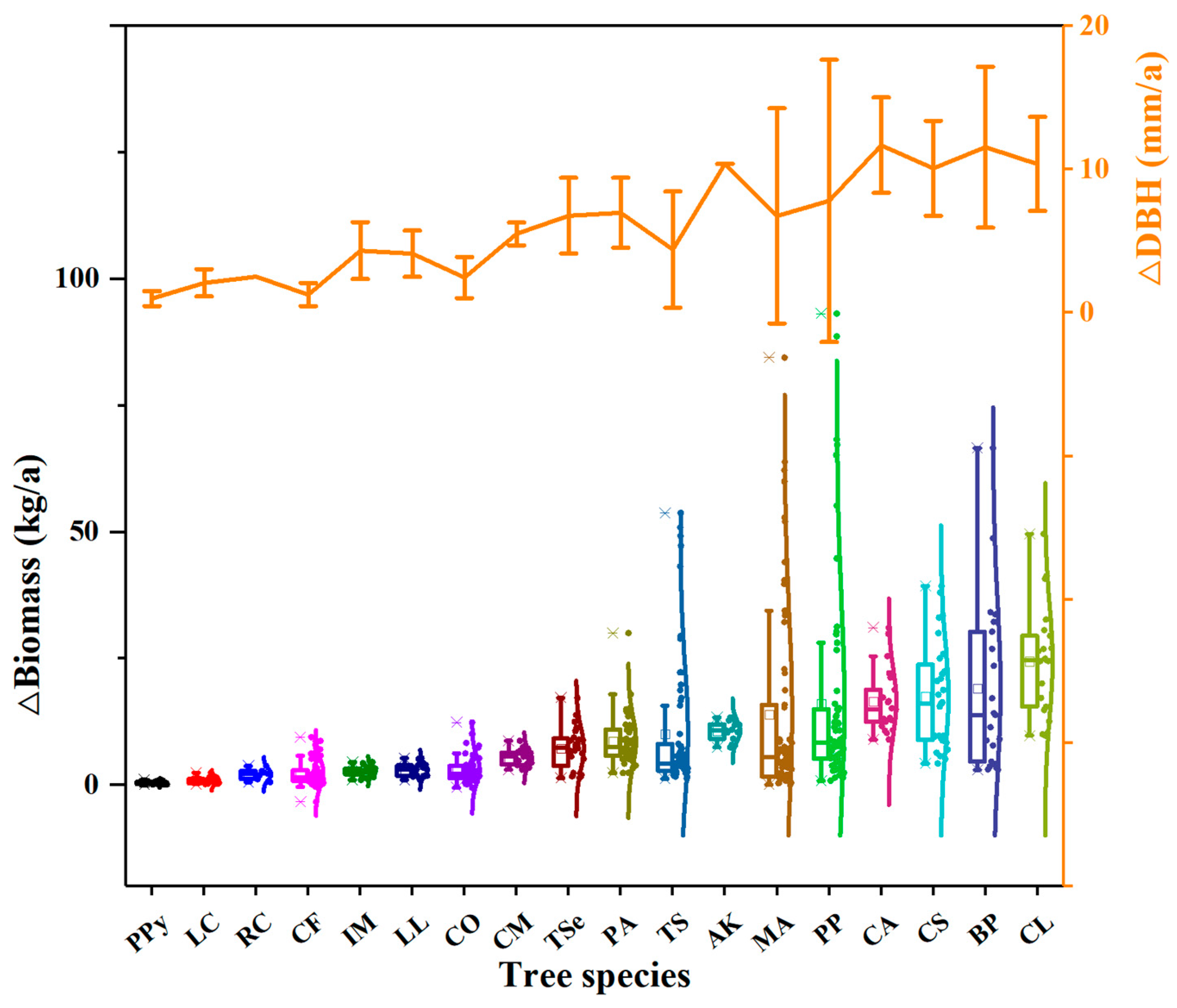
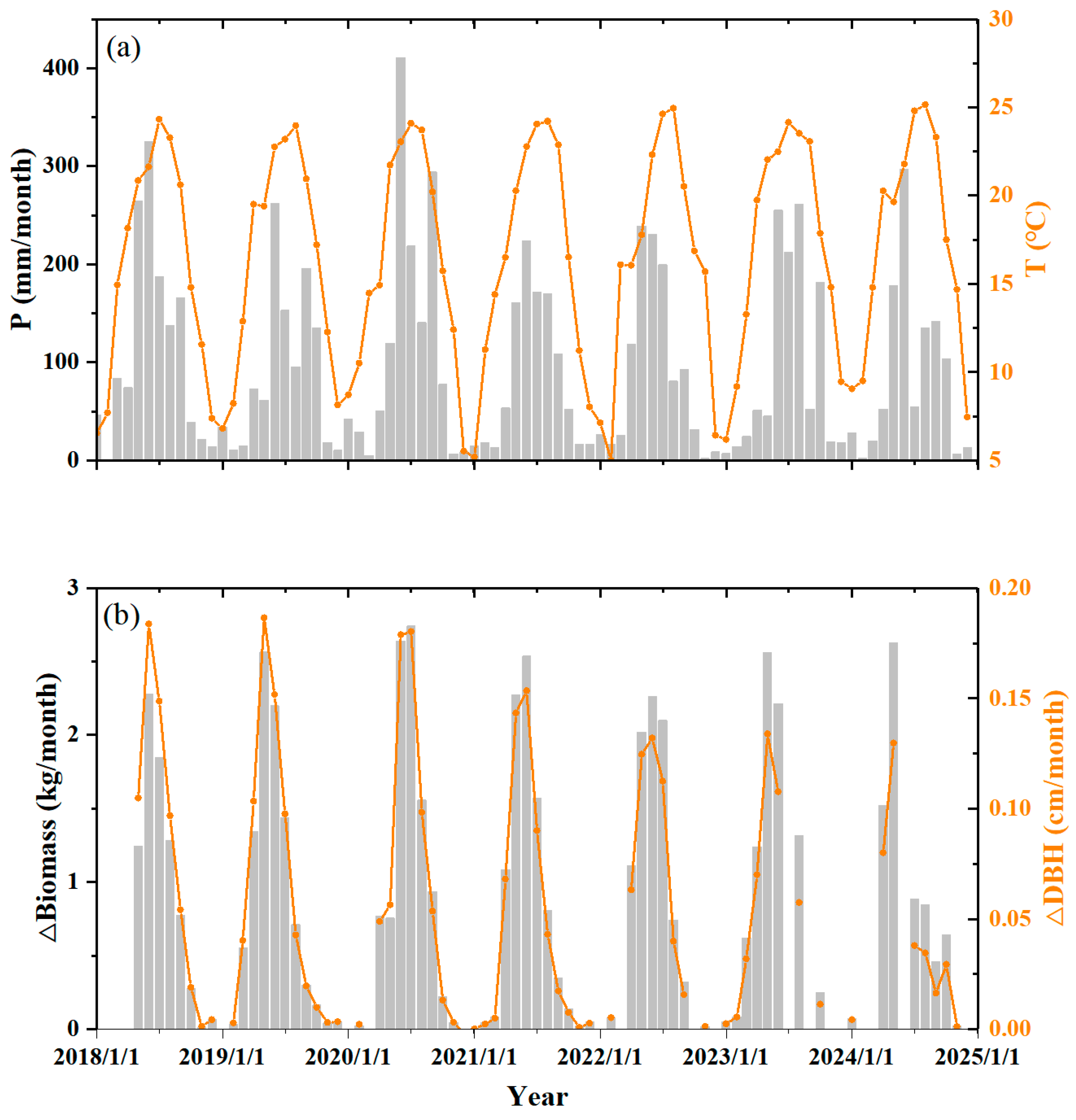
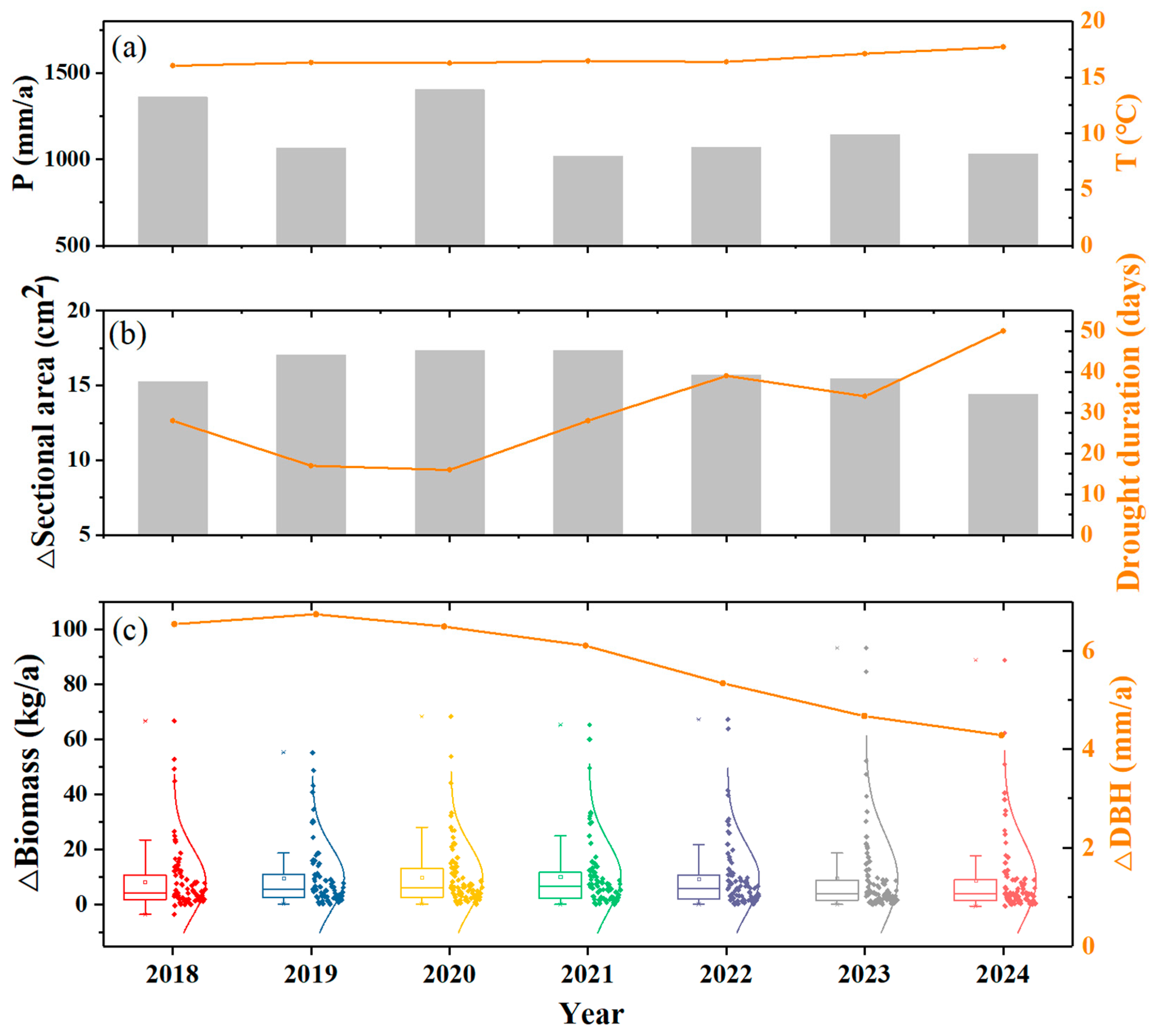
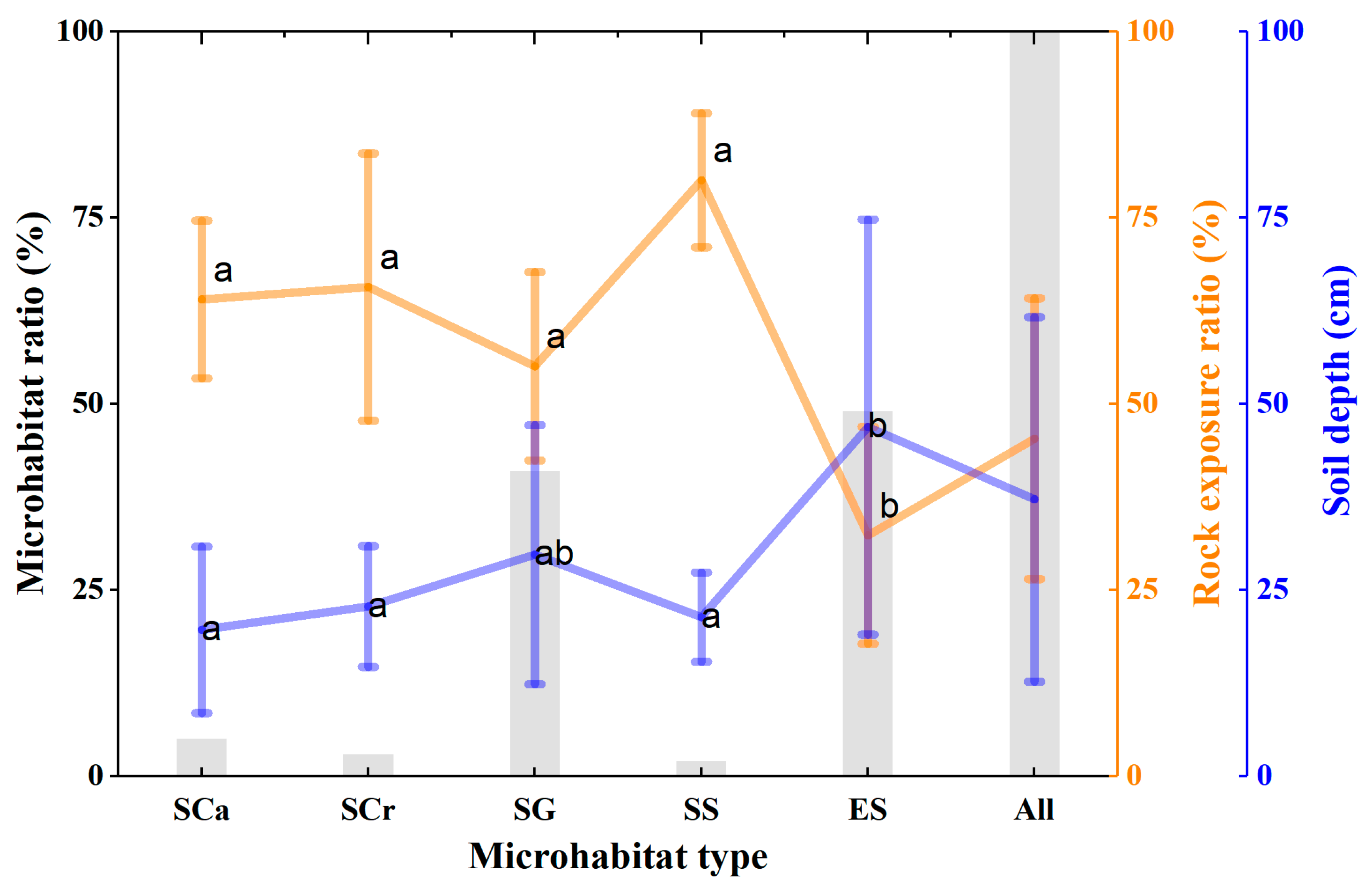
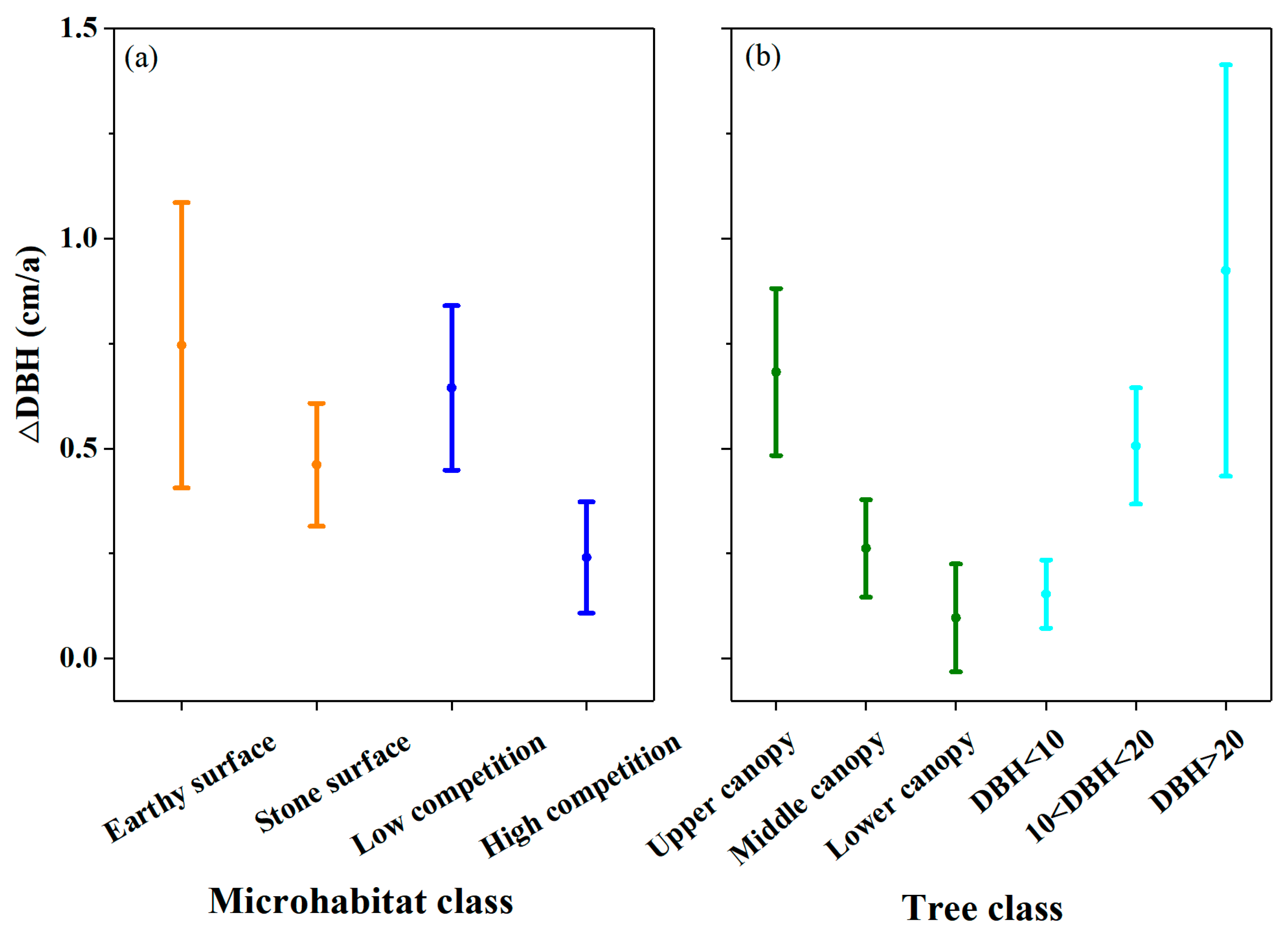
| Latin Names | Initial Number of Monitored Trees | Regression Models | Initial Mean DBH (cm) | Number of Dead Trees |
|---|---|---|---|---|
| Melia azedarach (MA) | 10 | y = 2.0141(D 2 H) 0.889 | 17.02 ± 7.16 | 1 |
| Platyosprion platycarpum (PP) | 9 | y = 2.0141(D 2 H) 0.889 | 20.77 ± 9.23 | 0 |
| Catalpa fargesii (CF) | 9 | y = 2.0141(D 2 H) 0.889 | 17.33 ± 6.95 | 0 |
| Populus adenopoda (PA) | 9 | y = 2.0141(D 2 H) 0.889 | 12.47 ± 7.26 | 0 |
| Toona sinensis (TS) | 9 | y = 2.0141(D 2 H) 0.889 | 19.78 ± 10.69 | 0 |
| Catalpa ovata (CO) | 9 | y = 2.0141(D 2 H) 0.889 | 14.41 ± 3.14 | 1 |
| Broussonetia papyrifera (BP) | 4 | y = 2.0141(D 2 H) 0.889 | 14.55 ± 7.84 | 1 |
| Populus canadensis Moench (PC) | 4 | y = 2.0141(D 2 H) 0.889 | 28.87 ± 8.98 | 4 |
| Celtis sinensis (CS) | 4 | y = 2.0141(D 2 H) 0.889 | 9.33 ± 1.36 | 0 |
| Triadica sebifera (TSe) | 4 | y = 2.0141(D 2 H) 0.889 | 8.11 ± 1.48 | 0 |
| Rhus chinensis (RC) | 4 | y = 2.0141(D 2 H) 0.889 | 10.31 ± 1.52 | 3 |
| Castanea mollissima (CM) | 3 | y = 2.0141(D 2 H) 0.889 | 12.38 ± 2.65 | 0 |
| Ilex macrocarpa (IM) | 3 | y = 2.0141(D 2 H) 0.889 | 7.3 ± 1.81 | 0 |
| Pyrus pyrifolia (PPy) | 3 | y = 2.0141(D 2 H) 0.889 | 7.33 ± 0.94 | 0 |
| Choerospondias axillaris (CA) | 3 | y = 2.0141(D 2 H) 0.889 | 11.03 ± 1.15 | 0 |
| Ligustrum lucidum (LL) | 3 | y = 2.0141(D 2 H) 0.889 | 8.49 ± 1.59 | 0 |
| Albizia kalkora (AK) | 3 | y = 2.0141(D 2 H) 0.889 | 9.42 ± 0.58 | 1 |
| Cunninghamia lanceolata (CL) | 3 | y = 2.0141(D 2 H) 0.889 | 17.44 ± 2.94 | 0 |
| Lindera communis (LC) | 3 | y =1.0101 (D 2 H) 0.8344 | 6.73 ± 0.41 | 0 |
| Species | Mean DBH Increment (cm/a) | Mean Biomass Accumulation (kg/a) |
|---|---|---|
| CA | 1.17 ± 0.4 a | 16.45 ± 6.28 abcd |
| BP | 1.16 ± 0.76 a | 19.04 ± 17.09 ab |
| AK | 1.04 ± 0.34 ab | 10.67 ± 1.96 bcde |
| CL | 1.04 ± 0.44 ab | 24.45 ± 10.83 a |
| CS | 1.01 ± 0.39 ab | 17.44 ± 10.42 abc |
| PP | 0.78 ± 0.96 ab | 16.11 ± 20.81 abc |
| PA | 0.7 ± 0.33 bc | 8.69 ± 4.7 bcde |
| TSe | 0.68 ± 0.29 bc | 7.23 ± 4.11 cde |
| MA | 0.68 ± 0.75 bc | 13.92 ± 19.43 bcd |
| CM | 0.55 ± 0.15 bcd | 5.37 ± 1.56 de |
| TS | 0.44 ± 0.42 cd | 10.07 ± 13.24 bcde |
| IM | 0.43 ± 0.19 cd | 2.71 ± 0.92 e |
| LL | 0.41 ± 0.2 cd | 2.99 ± 1.22 e |
| RC | 0.25 ± 0.13 cd | 2.11 ± 1.06 e |
| CO | 0.25 ± 0.2 d | 3.03 ± 2.68 e |
| LC | 0.21 ± 0.16 d | 0.87 ± 0.63 e |
| CF | 0.13 ± 0.1 d | 2.37 ± 2.61 e |
| PPy | 0.1 ± 0.07 d | 0.43 ± 0.3 e |
| Surveyed Trees (DBH > 3 cm) Within a 3 m Radius of Each Monitored Tree | Crown Exposure to Sunlight of Each Monitored Tree (%) | Number of Monitored Trees with Parasitization | |||||
|---|---|---|---|---|---|---|---|
| Total Number | Total Species | Mean DBH (cm) | Mean Height (m) | Upper Crown | Middle Crown | Lower Crown | |
| 706 | 32 | 7.9 | 7 | 86 | 53 | 30 | 10 |
Disclaimer/Publisher’s Note: The statements, opinions and data contained in all publications are solely those of the individual author(s) and contributor(s) and not of MDPI and/or the editor(s). MDPI and/or the editor(s) disclaim responsibility for any injury to people or property resulting from any ideas, methods, instructions or products referred to in the content. |
© 2025 by the authors. Licensee MDPI, Basel, Switzerland. This article is an open access article distributed under the terms and conditions of the Creative Commons Attribution (CC BY) license (https://creativecommons.org/licenses/by/4.0/).
Share and Cite
Cai, X.; Wang, Y.; Luo, W.; Wu, Y.; Cheng, A.; Chen, J.; Zhang, L.; Wang, S. Characteristics of Tree Growth at the Early Stage of Natural Succession on Abandoned Farmland in Southwest China’s Karst Region. Forests 2025, 16, 674. https://doi.org/10.3390/f16040674
Cai X, Wang Y, Luo W, Wu Y, Cheng A, Chen J, Zhang L, Wang S. Characteristics of Tree Growth at the Early Stage of Natural Succession on Abandoned Farmland in Southwest China’s Karst Region. Forests. 2025; 16(4):674. https://doi.org/10.3390/f16040674
Chicago/Turabian StyleCai, Xianli, Yanwei Wang, Weijun Luo, Yangyang Wu, Anyun Cheng, Jia Chen, Lin Zhang, and Shijie Wang. 2025. "Characteristics of Tree Growth at the Early Stage of Natural Succession on Abandoned Farmland in Southwest China’s Karst Region" Forests 16, no. 4: 674. https://doi.org/10.3390/f16040674
APA StyleCai, X., Wang, Y., Luo, W., Wu, Y., Cheng, A., Chen, J., Zhang, L., & Wang, S. (2025). Characteristics of Tree Growth at the Early Stage of Natural Succession on Abandoned Farmland in Southwest China’s Karst Region. Forests, 16(4), 674. https://doi.org/10.3390/f16040674






